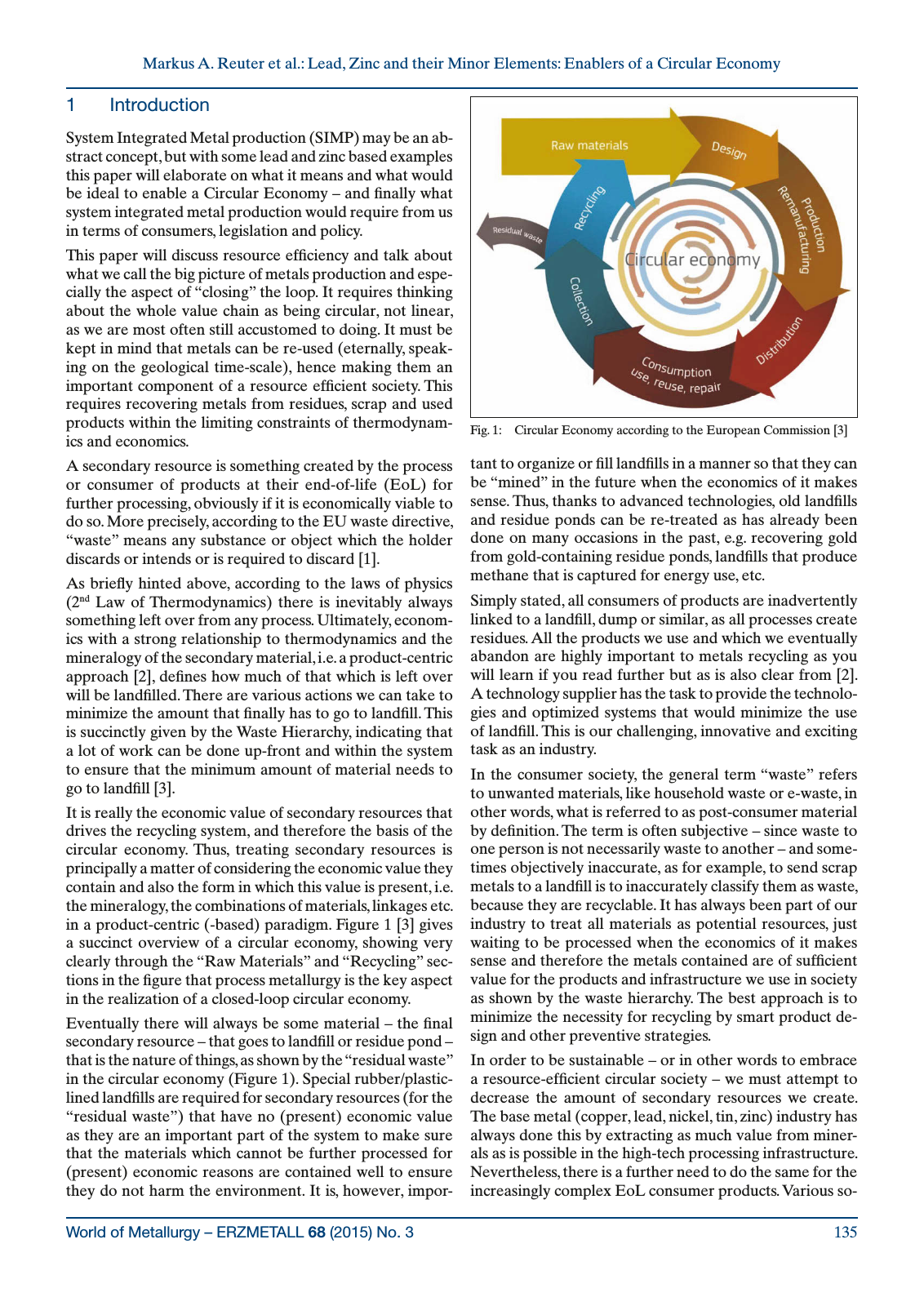World of Metallurgy ERZMETALL 68 2015 No 3 135 Markus A Reuter et al Lead Zinc and their Minor Elements Enablers of a Circular Economy 1 Introduction System Integrated Metal production SIMP may be an ab stract concept but with some lead and zinc based examples this paper will elaborate on what it means and what would be ideal to enable a Circular Economy and finally what system integrated metal production would require from us in terms of consumers legislation and policy This paper will discuss resource efficiency and talk about what we call the big picture of metals production and espe cially the aspect of closing the loop It requires thinking about the whole value chain as being circular not linear as we are most often still accustomed to doing It must be kept in mind that metals can be re used eternally speak ing on the geological time scale hence making them an important component of a resource efficient society This requires recovering metals from residues scrap and used products within the limiting constraints of thermodynam ics and economics A secondary resource is something created by the process or consumer of products at their end of life EoL for further processing obviously if it is economically viable to do so More precisely according to the EU waste directive waste means any substance or object which the holder discards or intends or is required to discard 1 As briefly hinted above according to the laws of physics 2nd Law of Thermodynamics there is inevitably always something left over from any process Ultimately econom ics with a strong relationship to thermodynamics and the mineralogy of the secondary material i e a product centric approach 2 defines how much of that which is left over will be landfilled There are various actions we can take to minimize the amount that finally has to go to landfill This is succinctly given by the Waste Hierarchy indicating that a lot of work can be done up front and within the system to ensure that the minimum amount of material needs to go to landfill 3 It is really the economic value of secondary resources that drives the recycling system and therefore the basis of the circular economy Thus treating secondary resources is principally a matter of considering the economic value they contain and also the form in which this value is present i e the mineralogy the combinations of materials linkages etc in a product centric based paradigm Figure 1 3 gives a succinct overview of a circular economy showing very clearly through the Raw Materials and Recycling sec tions in the figure that process metallurgy is the key aspect in the realization of a closed loop circular economy Eventually there will always be some material the final secondary resource that goes to landfill or residue pond that is the nature of things as shown by the residual waste in the circular economy Figure 1 Special rubber plastic lined landfills are required for secondary resources for the residual waste that have no present economic value as they are an important part of the system to make sure that the materials which cannot be further processed for present economic reasons are contained well to ensure they do not harm the environment It is however impor tant to organize or fill landfills in a manner so that they can be mined in the future when the economics of it makes sense Thus thanks to advanced technologies old landfills and residue ponds can be re treated as has already been done on many occasions in the past e g recovering gold from gold containing residue ponds landfills that produce methane that is captured for energy use etc Simply stated all consumers of products are inadvertently linked to a landfill dump or similar as all processes create residues All the products we use and which we eventually abandon are highly important to metals recycling as you will learn if you read further but as is also clear from 2 A technology supplier has the task to provide the technolo gies and optimized systems that would minimize the use of landfill This is our challenging innovative and exciting task as an industry In the consumer society the general term waste refers to unwanted materials like household waste or e waste in other words what is referred to as post consumer material by definition The term is often subjective since waste to one person is not necessarily waste to another and some times objectively inaccurate as for example to send scrap metals to a landfill is to inaccurately classify them as waste because they are recyclable It has always been part of our industry to treat all materials as potential resources just waiting to be processed when the economics of it makes sense and therefore the metals contained are of sufficient value for the products and infrastructure we use in society as shown by the waste hierarchy The best approach is to minimize the necessity for recycling by smart product de sign and other preventive strategies In order to be sustainable or in other words to embrace a resource efficient circular society we must attempt to decrease the amount of secondary resources we create The base metal copper lead nickel tin zinc industry has always done this by extracting as much value from miner als as is possible in the high tech processing infrastructure Nevertheless there is a further need to do the same for the increasingly complex EoL consumer products Various so Fig 1 Circular Economy according to the European Commission 3 Figure 1 Reuter

Hinweis: Dies ist eine maschinenlesbare No-Flash Ansicht.
Klicken Sie hier um zur Online-Version zu gelangen.
Klicken Sie hier um zur Online-Version zu gelangen.